第7章 Polymorphism 多态
7.1 类型转换 Conversions
(1)public继承,应该包含替换:即将子类转成父类(子类是父类的超集)
(a)如果B是A的子类,那么能使用A的地方,一定能使用B
(b)如果B是A的子类,那么对A成立的,对B也成立
class A{
int m_a;
public:
int getA(){m_a = 0; return m_a;}
}
class B : public A{
int getA(){m_a = 10; return m_a;}
}
void func(A a){
cout << getA();
}
int main(){
B b_ins;
func(b_ins);
}
|
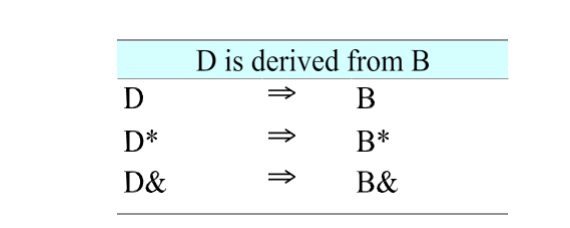
7.1.1 向上转换 Upcast
Manager pete("Pete", "444-55-6666", "Bakey");
Employee* ep = &pete;
Employee& er = pete;
ep->print( cout );
|
例:drawing
1 具体对象、共有数据、接口
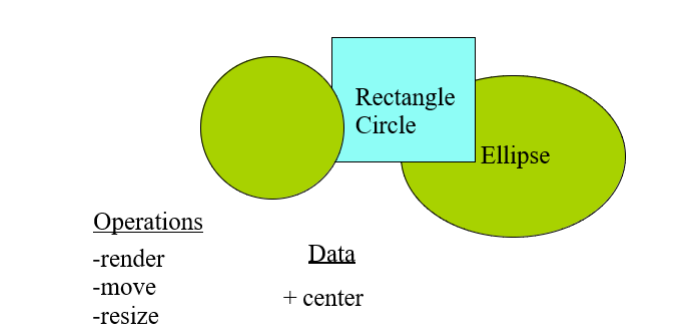
2 继承结构

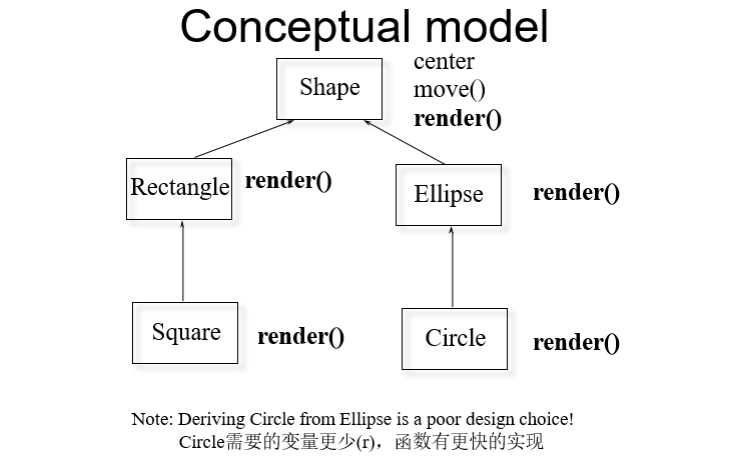
在父类Shape中,定义了接口render()
在子类中,通过多态的机制,重定义接口render()
3 类的声明
class XYPos{ ... };
class Shape {
protected:
XYPos center;
public:
Shape();
virtual ~Shape();
virtual void render();
void move(const XYPos&);
virtual void resize();
};
|
7.2 多态 Polymorphism
向上转换upcast:将子类的对象作为父类的一个对象
多态使用的时间:upcast
多态的目的:在upcast的时候,使用子类的对象
动态绑定binding:
绑定binding:调用哪个函数
静态绑定static
binding:调用函数作为代码
动态绑定dynamic binding:调用对象的函数
7.2.1 non-virtual function
(1)视为静态绑定,编译时就确定好使用哪个函数
(2)调用较快
7.2.2 virtual function
- 子类一定要重定义该函数
- 对象存储了虚函数的信息
- 编译器会检查、并动态调用正确的函数
- 编译器优化:如果编译器在编译的时候知道应该调用哪个函数,则会生成一个静态调用
class Ellipse : public Shape {
protected:
float major_axis, minor_axis;
public:
Ellipse(float maj, float minr);
virtual void render();
};
class Circle : public Ellipse {
public:
Circle(float radius):Ellipse(radius, radius){}
virtual void render();
};
void render(Shape* p) {
p->render();
}
void func() {
Ellipse ell(10, 20);
ell.render();
Circle circ(40);
circ.render();
render(&ell);
render(&circ);
}
|
7.3 抽象基础类 Abstract base
classes
7.3.1 定义
- 一个抽象的基础类有纯虚函数pure virtual
functions
- 只定义返回值、参数
- 不需要给函数体
- 抽象基础类不能直接实例化≠不能用指针
必须由一个子类继承
子类必须要实现抽象类的所有纯虚函数
7.3.2 例:定义纯虚函数
class XYPos{ ... };
class Shape {
protected:
XYPos center;
public:
Shape();
virtual void render() = 0;
void move(const XYPos&);
virtual void resize();
};
|
7.3.3 作用
(1)便于建模 ==> 抽象定义
(2)强制要求正确的行为 ==> 所有子类都必须有该行为
(3)定义接口,而不是定义实现
7.3.4 例:定义抽象类
class CDevice {
public:
virtual ~CDevice();
virtual int read(...) = 0;
virtual int write(...) = 0;
virtual int open(...) = 0;
virtual int close(...) = 0;
virtual int ioctl(...) = 0;
};
|
(1)所有非静态的成员函数都是纯虚函数,除了析构函数
(2)虚拟析构函数,没有函数体
(3)没有非静态的成员变量,可以有静态成员变量
7.4 Virtual的实现机制
(1)在内存中,会存储一个指针,指向当前类的虚函数表
(2)一个class会有一个虚函数表
(3)父类的变量会在子类的变量之前
(4)子类的虚函数表中,不会有父类的虚函数表,因为子类已经将所有虚函数重新定义了
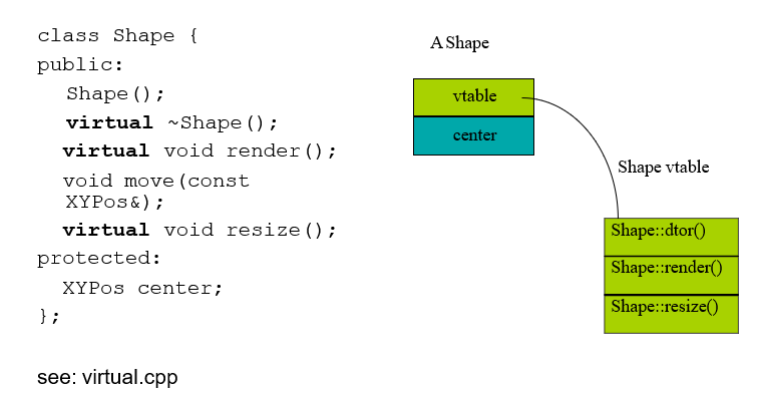


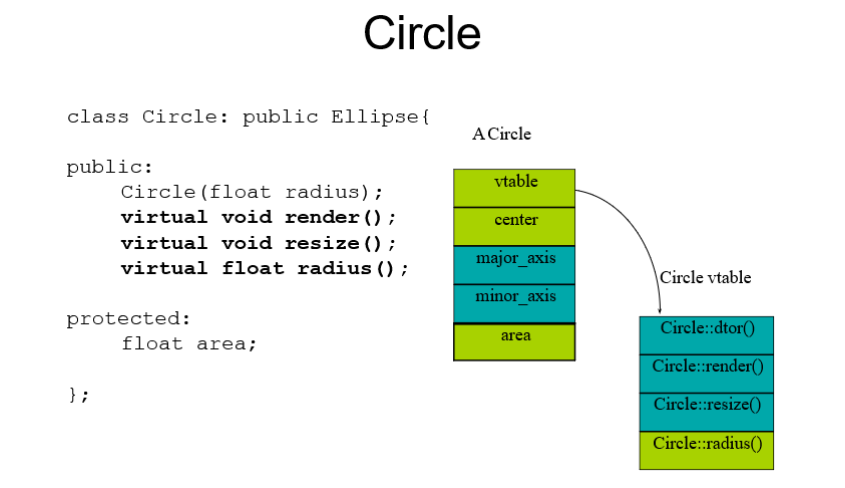
7.5 赋值与upcast
Ellipse elly(20f,40f);
Circle circ(60f);
elly = circ;
elly.render();
Ellipse *elly = new Ellipse(20f,40f);
Circle *circ = new Circle(60f);
elly = circ;
elly->render();
|
7.6 Relaxation
虚函数的返回类型为指针、引用的时候,子类可以修改返回类型
虚函数的返回类型为class的时候,子类不能修改返回类型
class Expr{
public:
virtual Expr* newExpr();
virtual Expr& clone();
virtual Expr self();
}
class BinaryExpr: public Expr{
public:
virtual BinaryExpr* newExpr();
virtual BinaryExpr& clone();
}
|
7.7 Overloading and virtuals
重载的几个函数,都需要被子类重定义
class Bass{
public:
virtual void func();
virtual void func(int);
}
class Derived: public Base{
public:
virtual void func(){
Base::func();
}
virtual void func(int){...};
}
|
7.8 注意
(1)不要重新定义non-virtual的函数
(2)不要重定义继承函数的缺省值
class A {
public:
A() { f();}
virtual void f() { cout << "A::f()"; }
};
class B : public A {
public:
B() { f();}
void f() { cout << "B::f()"; }
};
|







